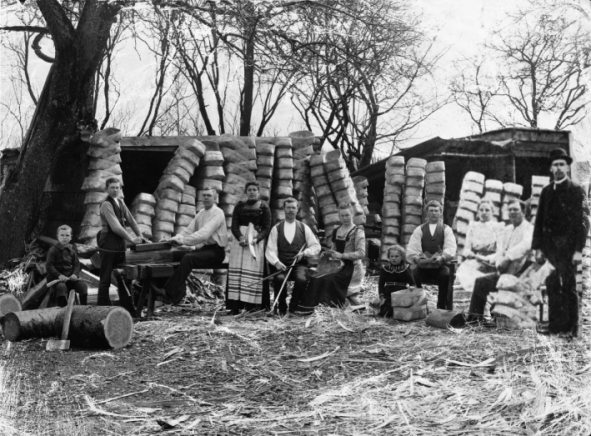| |
On the fig. 1 from Allerød 1902 you can see the steps of the
production. It was used for advertising -- on its back we find
the price list. Later on they used machinery, if they could,
and I will try to explain this to some degree. From the left:
1. We see the axe, with the log ready to be divided in parts and
barked.
2. Two men with the plane, with a part of the log fixed in a
carpenters bench, ready to make the splints. This was later replaced by machinery.
3. A woman with splints and a knife to make the fit for the
plaiting in correct breadth. This proces was also eventually
replaced by machinery.
4. A man making the rims or borders, in the same way which they
did in yet older days and still today make the splints in Dalarne
in Sweden.
5. A woman making the second part of the plaiting. For the first
part, the making or plaiting of the "bottom",see fig.2.

The
bowed side of the splints turned down when you plait the
bottom, and turned out, when you "plait up".
6. A man placing the outer rim, after he has nailed it together.
7. A woman (my grandmother in this illustration) cuts the
splints down to the rim, a little rough, with a sharp, sharp
knife!
8. A man (my grandfather) who placed the inner rim. It is first
placed for measuring, then moved out and nailed, placed again, and
then you make the four corners of the basket by bending it
over a piece of iron. Then you cut the splints down to the rims
one more time, and this time carefully, and make sure that the
whole basket is nice and o.k. O! they tell about my
grandfather, that he counted the corners in German - eins zwei
drei - and when he said - vier - then he had already thrown the
basket aside. Then the person who would cut along the rims had
to make the fourth corner. You do not see this on the picture,
because this would be done by one of the persons in the picture
who at that time was occupied with a more important part of the
process! You do not either see the making of the handle for the
same reason. It is made with the same technique as the rims. You
could say as three or four splints, which you do not split at one
end. The splint baskets were made from pine, which was shipped by railway from Sweden to Denmark, which then was stored in
a little lake, as seen on the fig.3,

because it has to be
wet when used. The cleaving of the logs and the barking was made
outside or in the open barn next to the lake.
The production itself took place in the factory. When the baskets
were made, they had to be dried upstairs, or in summertime in the
building you see top left on fig.3,
The walls of this building were made by boards placed like half closed Venetian
blinds, to allow the wind, but not the light, to get through! I
have never seen a house like that. The smell of the drying
baskets and a few sun rays through the baskets let the light
materialise in the dancing of dust! The splint baskets here
described were made in 12 different size -- see the copy of the
price list fig. 4

for the dimensions. The basket nr. 3 was the
most common and nr. 1 the least common, but I succeeded in finding
an example for my collection. In 25 years I think, I have only
seen one like this!
Finally, something about other splint baskets. There were other
ways of plaiting. One method was called scissors-plaiting. The
bottom in this case is often a board. A special kind of
splintbasket is not on the price list, because my father did not
like to make this basket. It was a round one, and because of my
father's success with this in Denmark, they started to make
them in Sweden too, and called it the Dane! My father did not
like this basket, because it needed much care to make, and he
could not get a good enough price for it! In the late 1950's and
in the sixties they were very popular and he made them, but did
not put them on the price lists! |
|


 Back to Splint basket page 1
Back to Splint basket page 1 Back to homepage.
Back to homepage.